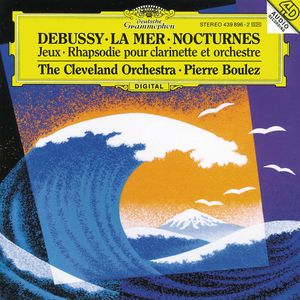Debussy: La Mer


Claude Debussy’s symphonic poem La Mer is one of the most frequently performed work and a staple in orchestral repertoire. It’s familiarity earns its place among pantheon of warhorses such as Tchaikovsky’s last three symphonies and Beethoven’s Fifth symphony – in case sometimes familiarity breeds contempt as they say. Why? Despite its familiarity, the work still remains revolutionary yet tolerable in the ears of musically conservative. Note the opening notes at the beginning which the harp imitates Javanese gamelan for example and as Peter Gutmann explains in his analysis of La Mer recordings other traits such as ornamental lines tracing back to Bach, influences of harmonic range of Chopin and Straussian orchestral colour. It is a wonder conservatives like Toscanini championed the work while works of other composers in Debussy’s time such as Mahler and Second Viennese school composers (Schoenberg, Webern, Berg) gets harder attention. The work retains the form of a standard symphony as observed by critic Louis Laloy in its premier that “the three movements have role and form of a first movement, scherzo and finale of a symphony”. Yet the first movement for example, does not adhere to typical sonata allegro form and Debussy utilizes uses of motifs and imaginative (in terms of radical and unusual) orchestral writing skills to conjure various moods and impressions of the sea throughout the three movements.
Debussy actually intended to depict the “feelings” of the sea rather than reproduction of nature. The composer originally intended to become a sailor and was encouraged by his father who was an ex-Navy man who ran a china shop. His father’s business collapsed and young Debussy caught up in trouble and was sent to prison. Debussy was released after a year and he stayed with a friend of family, who happens to be mother-in law of poet Paul Verlaine. She steered Debussy to his destiny of being a musician by sending him to Paris Conservatoire and the rest is history. Even so, Debussy still retained his feelings to the sea, particularly when he ran away from his wife and seek refuge to his mistress at an island somewhere in the English Channel. A reproduced print of Hokusai woodblock print “The Hollow Wave of Kanagawa” gave him inspiration, particularly the curl of a giant wave and he asked his publisher Jacques Durand to reproduce the work on the cover of the printed score.
There are a few famous recordings of the work that I have listened particularly by one of great French music exponents Charles Munch’s record with Boston Symphony Orchestra. Herbert von Karajan’s recorded this work with Berlin Philharmonic Orchestra on both EMI and Deutche Grammophon labels and the latter I’ve heard exposes the work’s great elemental nature. The orchestra’s homogenous sound helps to greatly intensify the dynamic mood contrasts and the crescendos particularly on first and third movements are as powerful as the turbulence of the sea. Conductor Pierre Boulez’ recording with the Cleveland Orchestra is the my favorite and combining the maestro’s astounding ear for clarity, balance and analytical mind with the orchestra’s reputation of seamless orchestral blending and colour, the result is sensous. This is one of the very few classical recordings which literally is a feast of senses. The record boasts transparency and exposure of the score than many recordings yet sounds as focused and powerful as Karajan’s recording for DG.
Karajan/BPO (DG)
Interpretation: 8
Technical: 9
Recording: 9
Boulez/Cleveland (DG)
Interpretation: 9
Technical: 10
Recording: 10
